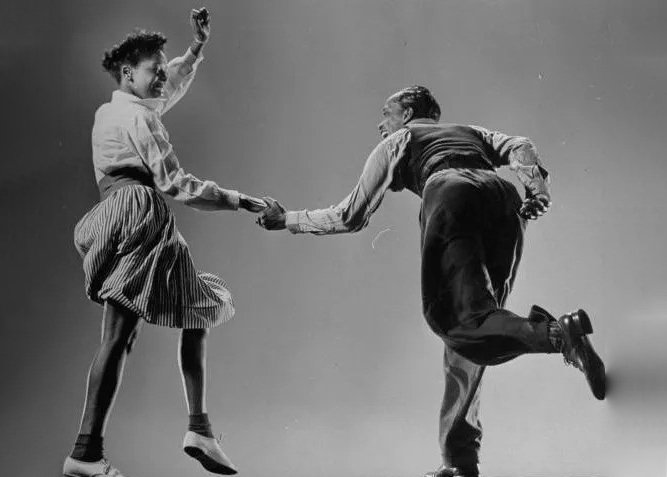
Swing dance is a celebration of black American culture
Swing dance styles at Groovy Moose
Balboa
Balboa, including pure-bal and bal-swing, originates from as early as 1915 and gained prominence in Southern California during the swing era of the 1920s and 1930s. Balboa is famous for its small, intricate footwork. But more than just a dance below the knees, balboa offers lots of exciting movements for leaders and followers, including twists, turns and twirls.
Lindy hop
Lindy Hop is the most popular style of swing dance. It was invented in 1927 by Black American dancers in Harlem, New York City. It became famous when it hit the dance floors of the Savoy Ballroom in 1928 and remained popular through the 1930s and 1940s. Lindy Hop is known for its energetic and bouncy movements, typically danced with 6 and 8-count steps.
Collegiate Shag
Collegiate Shag, a vibrant style of swing dance, traces its origins to the Black American communities of the Carolinas in the 1920s. This energetic dance is characterized by its distinctive 6-count and 8-count patterns, featuring rapid footwork and arms held high in the air. Often depicted in vintage nightclubs in films that showcase hot jazz and up-tempo swing, Collegiate Shag exudes a lively and hoppy energy that captivates dancers and audiences alike.
Solo jazz
You know that hip hop move, the 'running man'? Well, solo jazz is all those popular solo dance moves that were around in the 20's, 30's, 40's, and have long since been forgotten. That is, until swing dancers brought them all back!
Also known as authentic jazz, or vernacular jazz, solo jazz includes moves with names like Suzie Q, Shortie George, and Spank the Baby! But by far the most popular step that is still well-known today is the Charleston!
Swing dancers love to dance solo, but they'll also use those authentic jazz steps to make their partner dancing look and feel even better.
Swing dance history resources
Swing dance is a Black American artform. Both the music and the dance were expressions of defiance against the oppression and hardships that Black people were, and still are, facing. Our community owes its existence to this art form’s creators. This is why we need to honor it, not only by learning the steps, moves and techniques, but also form a more profound understanding of its history and culture. This is the only way we can contribute positively to its continued development, and provide a safe environment for people of color to feel welcome and appreciated within this community. We encourage you to use the resources below to help gain understanding of this artform that we celebrate.
-
Lindy Hop is a Black American Dance - Laura Glaess: https://youtu.be/My20UBtCvdY?si=2cBbJH-j5_WQ9h9w
Dance through Lindy Hop's Black American Roots | If Cities Could Dance - KQED Arts: https://www.youtube.com/watch?v=JkonZbTj2wE
-
May We Have This Dance? - Code Switch podcast: https://www.npr.org/2021/12/22/1066965712/may-we-have-this-dance
Integrated Rhythm podcast with Bobby White and Chisomo Selemani: https://creators.spotify.com/pod/show/integratedrhythm (podcast)
-
iLindy blog post series “Let’s talk about lindy hop and blackness” - Grey Armstrong: https://ilindy.com/blog/lets-talk-lindy-hop-and-blackness/
Swungover resources about swing dance history - Bobby White: https://swungover.wordpress.com/table-of-contents/swing-101-swing-history-101/
Lindy hop and anti-racism - SwingStep: https://swingstep.com/this-is-swing/lindy-hop-and-anti-racism/
Move together - Black Lindy Hopper’s Fund: https://drive.google.com/file/d/1hxA1yTQj8dRxaWXU0ZECDHqr2vLHrTSr/view
-
Additional resources - Collective Voices for Change: https://www.collectivevoicesforchange.org/resources
List of additional resources - Black Lindy Hoppers Fund: https://blacklindyhoppersfund.org/other-resources